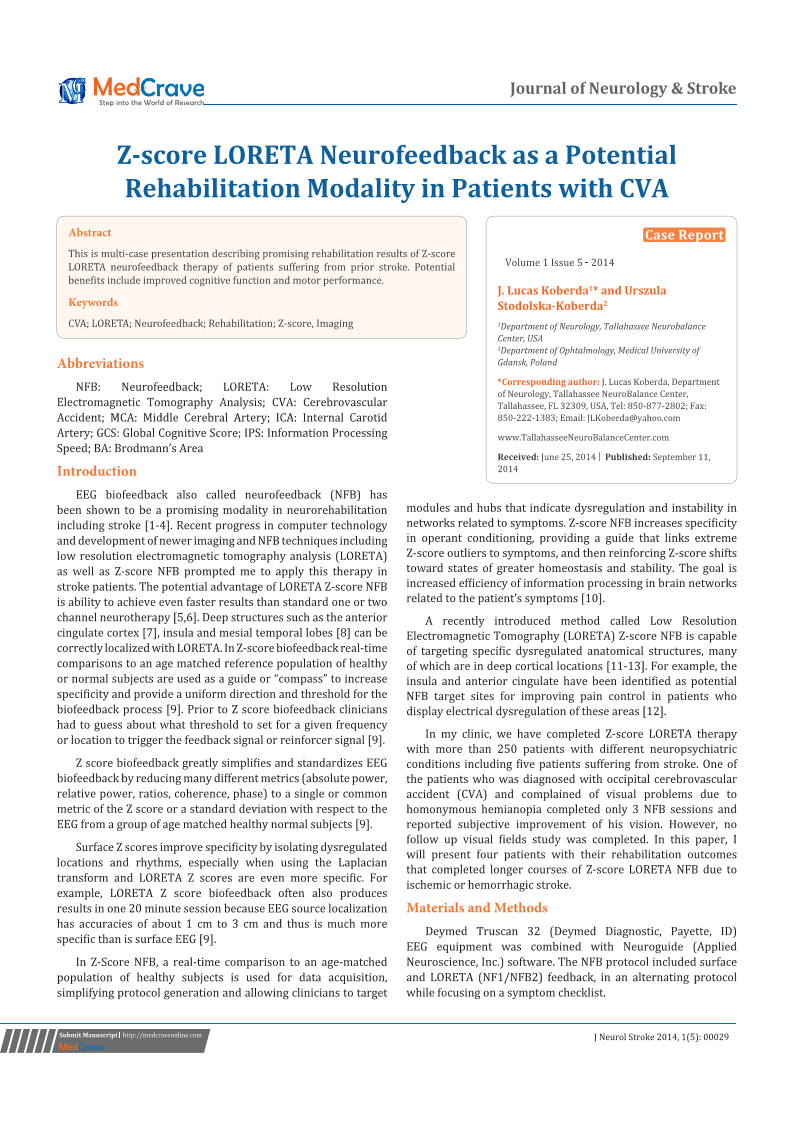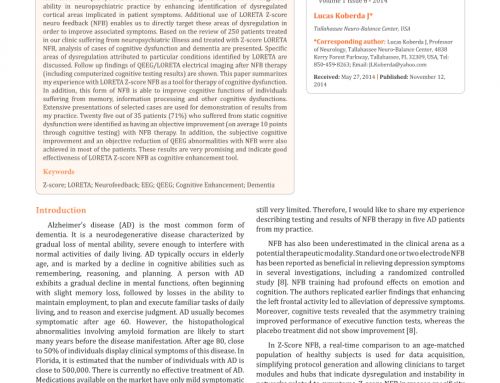Z-score LORETA Neurofeedback as a Potential Rehabilitation Modality in Patients with CVA
Journal of Neurology & Stroke
Published September 11, 2014
Click on image to read full report.
Abstract
This is multi-case presentation describing promising rehabilitation results of Z-score
LORETA neurofeedback therapy of patients suffering from prior stroke. Potential
benefits include improved cognitive function and motor performance.
Volume 1 Issue 5 – 2014
J. Lucas Koberda1* and Urszula Stodolska-Koberda2
1 Department of Neurology, Tallahassee Neurobalance
Center, USA
2 Department of Opthalmology, Medical University of
Gdansk, Poland
*Corresponding author: J. Lucas Koberda, Department
of Neurology, Tallahassee NeuroBalance Center,
Tallahassee, FL 32309, USA, Tel: 850-877-2802; Fax:
850-222-1383; Email:
www.TallahasseeNeuroBalanceCenter.com
Received: June 25, 2014 | Published: September 11,
2014
Keywords
CVA; LORETA; Neurofeedback; Rehabilitation; Z-score, Imaging, Stroke
Abbreviations
NFB: Neurofeedback; LORETA: Low Resolution
Electromagnetic Tomography Analysis; CVA: Cerebrovascular Accident; MCA: Middle Cerebral Artery; ICA: Internal Carotid Artery; GCS: Global Cognitive Score; IPS: Information Processing Speed; BA: Brodmann’s Area
Introduction
EEG biofeedback also called neurofeedback (NFB) has been shown to be a promising modality in neurorehabilitation including stroke [1-4]. Recent progress in computer technology and development of newer imaging and NFB techniques including
low resolution electromagnetic tomography analysis (LORETA) as well as Z-score NFB prompted me to apply this therapy in stroke patients. The potential advantage of LORETA Z-score NFB is ability to achieve even faster results than standard one or two channel neurotherapy [5,6]. Deep structures such as the anterior cingulate cortex [7], insula and mesial temporal lobes [8] can be correctly localized with LORETA. In Z-score biofeedback real-time comparisons to an age matched reference population of healthy or normal subjects are used as a guide or “compass” to increase specificity and provide a uniform direction and threshold for the biofeedback process [9]. Prior to Z score biofeedback clinicians had to guess about what threshold to set for a given frequency or location to trigger the feedback signal or reinforcer signal [9].
Z score biofeedback greatly simplifies and standardizes EEG biofeedback by reducing many different metrics (absolute power, relative power, ratios, coherence, phase) to a single or common metric of the Z score or a standard deviation with respect to the EEG from a group of age matched healthy normal subjects [9].
Surface Z scores improve specificity by isolating dysregulated locations and rhythms, especially when using the Laplacian transform and LORETA Z scores are even more specific. For example, LORETA Z score biofeedback often also produces results in one 20 minute session because EEG source localization has accuracies of about 1 cm to 3 cm and thus is much more specific than is surface EEG [9].
In Z-Score NFB, a real-time comparison to an age-matched population of healthy subjects is used for data acquisition, simplifying protocol generation and allowing clinicians to target modules and hubs that indicate dysregulation and instability in networks related to symptoms. Z-score NFB increases specificity in operant conditioning, providing a guide that links extreme Z-score outliers to symptoms, and then reinforcing Z-score shifts toward states of greater homeostasis and stability. The goal is increased efficiency of information processing in brain networks related to the patient’s symptoms [10].
A recently introduced method called Low Resolution Electromagnetic Tomography (LORETA) Z-score NFB is capable of targeting specific dysregulated anatomical structures, many of which are in deep cortical locations [11-13]. For example, the
insula and anterior cingulate have been identified as potential NFB target sites for improving pain control in patients who display electrical dysregulation of these areas [12].
In my clinic, we have completed Z-score LORETA therapy with more than 250 patients with different neuropsychiatric conditions including five patients suffering from stroke. One of the patients who was diagnosed with occipital cerebrovascular accident (CVA) and complained of visual problems due to homonymous hemianopia completed only 3 NFB sessions and reported subjective improvement of his vision. However, no follow up visual fields study was completed. In this paper, I will present four patients with their rehabilitation outcomes that completed longer courses of Z-score LORETA NFB due to
ischemic or hemorrhagic stroke. Read Full Study>>]]>
Stodolska-Koberda2
1 Department of Neurology, Tallahassee Neurobalance
Center, USA
2 Department of Opthalmology, Medical University of
Gdansk, Poland
*Corresponding author: J. Lucas Koberda, Department
of Neurology, Tallahassee NeuroBalance Center,
Tallahassee, FL 32309, USA, Tel: 850-877-2802; Fax:
850-222-1383; Email:
www.TallahasseeNeuroBalanceCenter.com
Received: June 25, 2014 | Published: September 11,
2014
Keywords
CVA; LORETA; Neurofeedback; Rehabilitation; Z-score, Imaging, Stroke
Abbreviations
NFB: Neurofeedback; LORETA: Low Resolution
Electromagnetic Tomography Analysis; CVA: Cerebrovascular Accident; MCA: Middle Cerebral Artery; ICA: Internal Carotid Artery; GCS: Global Cognitive Score; IPS: Information Processing Speed; BA: Brodmann’s Area
Introduction
EEG biofeedback also called neurofeedback (NFB) has been shown to be a promising modality in neurorehabilitation including stroke [1-4]. Recent progress in computer technology and development of newer imaging and NFB techniques including
low resolution electromagnetic tomography analysis (LORETA) as well as Z-score NFB prompted me to apply this therapy in stroke patients. The potential advantage of LORETA Z-score NFB is ability to achieve even faster results than standard one or two channel neurotherapy [5,6]. Deep structures such as the anterior cingulate cortex [7], insula and mesial temporal lobes [8] can be correctly localized with LORETA. In Z-score biofeedback real-time comparisons to an age matched reference population of healthy or normal subjects are used as a guide or “compass” to increase specificity and provide a uniform direction and threshold for the biofeedback process [9]. Prior to Z score biofeedback clinicians had to guess about what threshold to set for a given frequency or location to trigger the feedback signal or reinforcer signal [9].
Z score biofeedback greatly simplifies and standardizes EEG biofeedback by reducing many different metrics (absolute power, relative power, ratios, coherence, phase) to a single or common metric of the Z score or a standard deviation with respect to the EEG from a group of age matched healthy normal subjects [9].
Surface Z scores improve specificity by isolating dysregulated locations and rhythms, especially when using the Laplacian transform and LORETA Z scores are even more specific. For example, LORETA Z score biofeedback often also produces results in one 20 minute session because EEG source localization has accuracies of about 1 cm to 3 cm and thus is much more specific than is surface EEG [9].
In Z-Score NFB, a real-time comparison to an age-matched population of healthy subjects is used for data acquisition, simplifying protocol generation and allowing clinicians to target modules and hubs that indicate dysregulation and instability in networks related to symptoms. Z-score NFB increases specificity in operant conditioning, providing a guide that links extreme Z-score outliers to symptoms, and then reinforcing Z-score shifts toward states of greater homeostasis and stability. The goal is increased efficiency of information processing in brain networks related to the patient’s symptoms [10].
A recently introduced method called Low Resolution Electromagnetic Tomography (LORETA) Z-score NFB is capable of targeting specific dysregulated anatomical structures, many of which are in deep cortical locations [11-13]. For example, the
insula and anterior cingulate have been identified as potential NFB target sites for improving pain control in patients who display electrical dysregulation of these areas [12].
In my clinic, we have completed Z-score LORETA therapy with more than 250 patients with different neuropsychiatric conditions including five patients suffering from stroke. One of the patients who was diagnosed with occipital cerebrovascular accident (CVA) and complained of visual problems due to homonymous hemianopia completed only 3 NFB sessions and reported subjective improvement of his vision. However, no follow up visual fields study was completed. In this paper, I will present four patients with their rehabilitation outcomes that completed longer courses of Z-score LORETA NFB due to
ischemic or hemorrhagic stroke. Read Full Study>>]]>



